

Effect of Energy Treatment on Carrots. Title: Impact of Biofield Treatment on Yield, Quality and Control of Nematode in Carrots Select license: Creative Commons Attributions-NonCommercial-ShareAlike Updated: November 22nd, 2016 Abstract: This study tested the Null Hypothesis for the effect of biofield treatment when used for control of nematode on carrot crops, Daucus carota , under typical growing conditions in year 2012 at Guadalupe, California, USA. Carrots Yield Improvement. This study tested the Null Hypothesis for the effect of biofield treatment when used for control of nematode on carrot crops, Daucus carota , under typical growing conditions in year 2012 at Guadalupe, California, USA. Following biofield treatment, carrot seeds were planted in replicate plots with mechanical seeder and their development was recorded compared to control seed growth from untreated plots and plots treated with the commercial standard nematicide, further Vydate L was applied three times at rates of 1 and 0.5 gal/A, at 1, 18 and 35 days after seeding, respectively.
At 70 and 109 days after the first application root galling severity in biofield treated crops was reduced by 54% and 22% respectively as compared to untreated while the Vydate response showed 0% and 25% control, respectively. Energy Impact on Immunity of Carrots. Description This study tested the Null Hypothesis for the effect of biofield treatment when used for control of nematode on carrot crops, Daucus carota, under typical growing conditions in year 2012 at Guadalupe, California, USA.
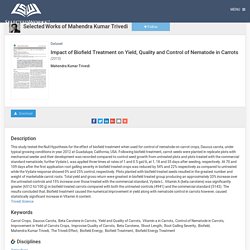
Following biofield treatment, carrot seeds were planted in replicate plots with mechanical seeder and their development was recorded compared to control seed growth from untreated plots and plots treated with the commercial standard nematicide, further Vydate L was applied three times at rates of 1 and 0.5 gal/A, at 1, 18 and 35 days after seeding, respectively.
At 70 and 109 days after the first application root galling severity in biofield treated crops was reduced by 54% and 22% respectively as compared to untreated while the Vydate response showed 0% and 25% control, respectively. Increase in Vitamin-A Content in Carrots. Nematode Control in Carrots - Biofield Treatment. Study of Daucus Carota Yield Improvement. Daucus Carota Nematode Control. Biotype Number Analysis. Effect of External Energy on Enterococcus Faecalis. Description Background: While spiritual and mental energies are known to man, their impact has never been scientifically measurable in the material world and they remain outside the domain of science.
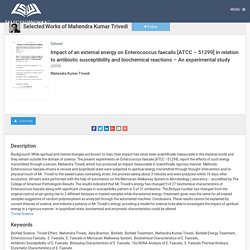
The present experiments on Enterococcus faecalis [ATCC –51299], report the effects of such energy transmitted through a person, Mahendra Trivedi, which has produced an impact measurable in scientifically rigorous manner. Methods: Enterococcus faecalis strains in revived and lyophilized state were subjected to spiritual energy transmitted through thought intervention and/or physical touch of Mr. Trivedi to the sealed tubes containing strain, the process taking about 3 minutes and were analyzed within 10 days after incubation. Citation Information Mahendra Kumar Trivedi. Enterococcus Faecalis Biochemical Characteristics. Enterococcus Faecalis' Antibiotic Susceptibility Pattern. Enterococcus Faecalis' Biochemical Reactions. Alteration in Enterococcus Faecalis Biotype Number. Characteristics of Enterococcus Faecalis. 1/14 JournalofAccordIntegrativeMedicine Copyright©2009Allrightsreserved.

Nopartofthispublicationmaybeusedor reproduced,storedinaretrievalsystem,ortransmittedinanyformsorbyanymeans, electronic,mechanical,photocopying,recordingorotherwise,withoutwritten permission. 2009,Volume5,Number1. Phenotyping and Genotyping Characterization of Serratia marcescens. Biochemical reactions.
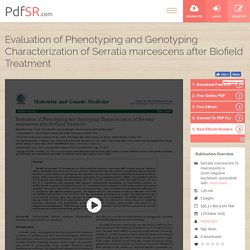
We also explored the genotyping of this organism using polymerase chain reaction (PCR) based methodologies of randomly amplied polymorphic DNA (RAPD) and 16S rDNA sequencing techniques. To the best of our knowledge, this is the rst. Human Energy Effect of 16S rDNA Sequence of S. Marcescens. Description Ammonium acetate and ammonium chloride are the white crystalline solid inorganic compounds having wide application in synthesis and analytical chemistry.

The aim of present study was to evaluate the impact of biofield treatment on spectral properties of inorganic salt like ammonium acetate and ammonium chloride. The study was performed in two groups of each compound i.e., control and treatment. Treatment groups were received Mr. Evaluation of Serratia Marcescens- Trivedi Effect. Serratia marcescens (S. marcescens) is Gram-negative bacterium, associated with hospital-acquired infections (HAIs), especially urinary tract and wound infections.
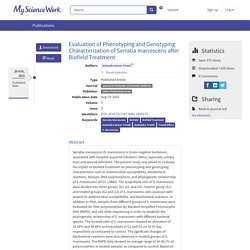
The present study was aimed to evaluate the impact of biofield treatment on phenotyping and genotyping characteristics such as antimicrobial susceptibility, biochemical reactions, biotype, DNA polymorphism, and phylogenetic relationship of S. marcescens (ATCC 13880). The lyophilized cells of S. marcescens were divided into three groups (G1, G2, and G3). Study of Drug-Resistant Microorganism of S. marcescens. Study of DNA Polymorphism of S. Marcescens.
Analysis of Microbial Resistance on Serratia Marcescens. Impact of Biofield Treatment on Antimicrobial Susceptibility of S. marcescens. Biofield Treatment’s impact on Salmonella Paratyphi. 0WordPress0CiteULike0 2 Enteric fever is a major global problem.
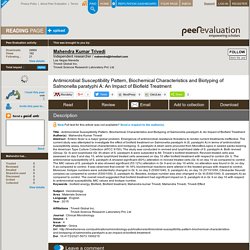
Emergence of antimicrobial resistance threatens to render current treatments ineffective. The current study was attempted to investigate the effect of biofield treatment on Salmonella paratyphi A (S. paratyphi A) in terms of antimicrobial susceptibility assay, biochemical characteristics and biotyping. S. paratyphi A strain were procured from MicroBioLogics in sealed packs bearing the American Type Culture Collection (ATCC 9150). The study was conducted in revived and lyophilized state of S. paratyphi A. Your session has expired but don’t worry, your message has been saved.Please log in and we’ll bring you back to this page. Minimum Inhibitory Concentration. Impact of Biofield treatment on Salmonella Paratyphi. Responding into useful way that is called biofield energy and the process is known as biofield treatment.

Energy Treatment Impact on the Characteristics of S. Paratyphi A. Description Enteric fever is a major global problem.

Emergence of antimicrobial resistance threatens to render current treatments ineffective. The current study was attempted to investigate the effect of biofield treatment on Salmonella paratyphi A (S. paratyphi A) in terms of antimicrobial susceptibility assay, biochemical characteristics and biotyping. S. paratyphi A strain were procured from MicroBioLogics in sealed packs bearing the American Type Culture Collection (ATCC 9150). The study was conducted in revived and lyophilized state of S. paratyphi A. Citation Information Trivedi MK, Branton A, Trivedi D, Nayak G, Shettigar H, et al. (2015) Antimicrobial Susceptibility Pattern, Biochemical Characteristics and Biotyping of Salmonella paratyphi A: An Impact of Biofield Treatment.
S. paratyphi – Alternative Strategy for Enteric Fever. Enteric fever is a major global problem.
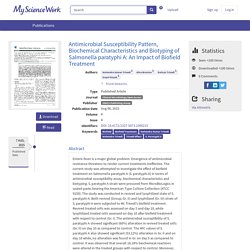
Emergence of antimicrobial resistance threatens to render current treatments ineffective. Salmonella Paratyphi. Biochemical Characteristics of S. Paratyphi A. Alteration in Antimicrobial Susceptibility Pattern of S. Paratyphi. Effect of Human Energy Treatment on N. otitidis. 16S rDNA Sequencing of N. otitidis. Title: Evaluation of Antibiogram, Genotype and Phylogenetic Analysis of Biofield Treated Nocardia otitidis Publication: Biological Systems: Open Access Select license: Creative Commons Attributions-NonCommercial-ShareAlike Updated: November 21st, 2016 Abstract: Nocardiosis is a soil-borne aerobic infection caused by Nocardia species commonly affects the respiratory tract. Study of N. otitidis Antimicrobials Susceptibility.
Citation: Trivedi MK, Branton A, Trivedi D, Nayak G, Mondal SC, et al. (2015) Evaluation of Antibiogram, Genotype and Phylogenetic Analysis of Bioeld Treated Nocardia otitidis. Biol Syst Open Access 4: 143. doi:10.4172/2329-6577.1000143. Genotyping and Phenotyping Analysis of N. otitidis. Description Nocardiosis is a soil-borne aerobic infection caused by Nocardia species commonly affects the respiratory tract. Nocardia otitidis (N. otitidis) is the key organism for non-mycobacterial tuberculosis. Biofield Treated N. otitidis. Susceptibility Pattern of Nocardia otitidis: Study of Biofield. Unique Energy Impact on Antibiogram of Nocardia otitidis.
Thermal Analysis of Cadmium Powder. Description Cadmium is widely utilized in nickel-cadmium batteries, stabilizers, and coating applications due to its versatile physico-chemical properties. Cadmium Powder. Cadmium Powder. Particle Size and Surface Area Analysis of Cadmium Powder. Atomic, Physical and Thermal Properties of Cadmium Powder. Abstract Cadmium is widely utilized in nickel-cadmium batteries, stabilizers, and coating applications due to its versatile physico-chemical properties.
XRD Analysis of Cadmium Powder. Properties of Cadmium Powder. Trivedi et al., J Thermodyn Catal 2015, 6:2. Research on Pseudomonas Fluorescens Antibiotic Susceptibility. Pseudomonas Fluorescens Characteristics – Human Energy Impact. Change in Pseudomonas Fluorescens Biochemical Reaction Pattern. Study of Pseudomonas Fluorescens Biochemical Characteristics. Pseudomonas Fluorescens Antibiotic Susceptibility Alterations. P. Fluorescens Biochemical Tests to Evaluate the Biofield Impact.
Spiritual Energy Impact on Pseudomonas Fluorescens Characteristics. Atomic Properties of Carbon Allotrope Powders. Description Scientists are searching for eluding link between spirituality and science. Carbon Allotrope Particle Size Analysis. Alteration in Carbon Allotrope Powders Properties. Deformation in Carbon Allotrope Powders. Characteristics of Carbon Allotrope Powders. Carbon Allotropes - XRD Analysis. Abstract Scientists are searching for eluding link between spirituality and science. Analysis of Deformation in Carbon Allotropes. GC-MS Analysis of Benzophenone. Description. DSC Analysis of Benzophenone. Thermal & Spectroscopic Properties of Benzophenone. The aim of the present study was to evaluate the impact of biofield energy treatment on the thermal, spectroscopic, and chemical properties of benzophenone.
The study was done using various analytical methods such as gas chromatography-mass spectrometry (GC-MS), high performance liquid chromatography (HPLC), differential scanning calorimetry (DSC), Fourier transform infrared (FT-IR) spectroscopy, and ultraviolet-visible (UV-Vis) spectroscopy. Assessment of Benzophenone UV Spectrum. Benzophenone IR Spectrum Analysis. Thermal Characterization of Benzophenone. Analysis of p-Chlorobenzophenone. Thermal Properties of p-Chlorobenzophenone. P-Chlorobenzophenone' FTIR Analysis. XRD Analysis of p-Chlorobenzophenone. Analysis of Physical Properties of p-CBP. Assessment of p-Chlorobenzophenone Characteristics. C. braakii - Biotype Number Analysis. Energy Healing Treatment: C. braakii.
Impact of Unique Energy Treatment on C. braakii. Study of Biochemical Reaction on Citrobacter braakii. Phenotyping and 16S rDNA Analysis of C. braakii. 16S rDNA Sequencing of Citrobacter braakii. Antimicrobial susceptibility test on Citrobacter braakii.
Phenotyping Analysis of Citrobacter braakii after Biofield. Mr. Trivedi’s Biofield Treatment. Effect of Spiritual Energy on Yersinia enterocolitica. Study of Yersinia enterocolitica [ATCC–23715] Biochemical Reaction- Yersinia enterocolitica. 16s rDNA Analysis of Yersinia enterocolitica. Yersinia enterocolitica. Antifungal Sensitivity Assay of Human Energy Treated Fungi. Investigation of Antifungal Sensitivity of Fungi. In Vitro Evaluation of Fungi for Antifungal Sensitivity. External Energy Impact on Antifungal Sensitivity Assay. Antifungal Susceptibility Testing for Candida. Antibiotic Susceptibility of Staphylococcus Epidermis. Effect of Energy Treatment on S. Epidermis. Staphylococcus Epidermis' Biofield Treatment. Biochemical Characteristics of Staphylococcus Epidermis.
Evaluation of Staphylococcus Epidermis Polymorphism. Staphylococcus Epidermis Lyophilization. Staphylococcus Epidermis Antibiotic Susceptibility. Isotope Abundance in M-Toluic Acid. M-Toluic Acid GC-MS Study. GC-MS Study of OTA After Energy Treatment. Energy Treatment Impact on Ortho Toluic Acid. Ashwagandha - GC-MS and NMR Analysis Studies.